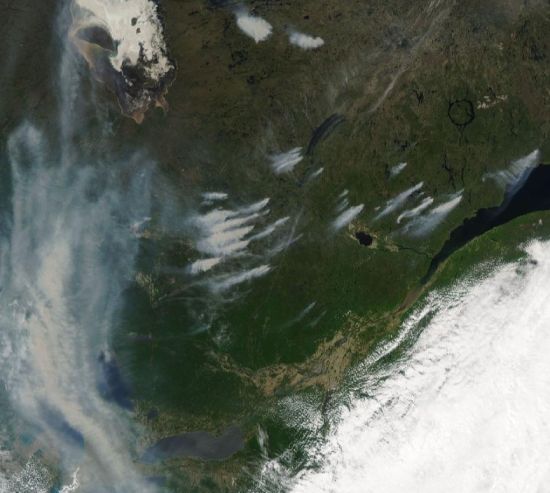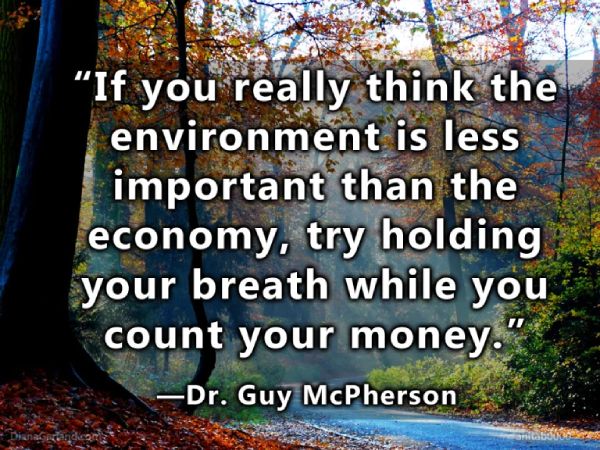I was recently asked if I could provide [my] “insights on the raging forest fire situation across Canada ... I have not found any data on the amount of C02 being expelled, the amount of dark ash/particulate matter covering arctic ice as a result of the fires, etc. anywhere online. I’d be curious to get your take on what kind of effects/feedbacks we can expect from all this.”
This request took me back to my Climate-Change Summary, a long essay you can find at guymcpherson.com. Last updated 2 August 2016, this essay contains considerable information rooted in the peer-reviewed literature.
As one result of the polar vortex, boreal peat dries and catches fire, as reported in The New York Times. A paper published in the renowned, peer-reviewed Nature on 23 December 2014 indicates “the amount of carbon stored in peats exceeds that stored in vegetation and is similar in size to the current atmospheric carbon pool.” The resulting soot enters the atmosphere to fall again, coating the ice surface elsewhere, thus reducing albedo and hastening the melting of ice. Each of these individual phenomena has been reported, albeit rarely, but to my knowledge the dots have not been connected beyond my work at guymcpherson.com.
The inability or unwillingness of the media to connect two dots is not surprising, and it has been routinely reported, including with respect to climate change and wildfires on 3 July 2013. In this case, the report came from Media Matters, and it was titled, STUDY: Media Still Largely Fail To Put Wildfires in Climate Context. Here’s the lead from the story published nearly 10 years ago: “A study of wildfire coverage from April through July 1 finds that print and TV media only mentioned climate change in 6 percent of coverage, although this was double the coverage from a year ago. While many factors must come together for wildfires to occur, climate change has led to hotter and drier conditions in parts of the West that have increased the risk of wildfires.”
A little meat on the bones seems in order regarding the statement that, “many factors must come together for wildfires to occur.” The many factors are three-fold, as I taught on campus for many years: (1) sufficient fuel to carry a fire, (2) a period of aridity sufficient to dry the fuel, so that it will ignite, and (3) a source of ignition. I’ll address each of these three points, in turn:
First, there is plenty of fuel, as guaranteed by more than a century of mismanagement, most notably in western North American. Second, a period of aridity comes every year in this region, and this effect has been exacerbated by abrupt, irreversible climate change. Even the stunningly conservative political body known as the Intergovernmental Panel on Climate Change reported in October 2018 and September 2019 that Earth is in the midst of abrupt and irreversible climate change, respectively. Third, sources of ignition are rampant in North America. Ignition sources that lead to wildfires are generally separated into two categories, lightning, and human-caused fires. Lightning commonly occurs in North America coincident with the dry season. And, because people are known neither for their intellect nor their wisdom, human-caused fires contribute to the many ignition sources. The combination of abundant dry fuel and various sources of ignition contribute to wildfires that emit trillions of tons of greenhouse gases every year. As Earth has become hotter during the last decade, and as many regions on Earth have become drier as a result, the reporting by the corporate media remains incomplete at best. I’ll now turn, again, to a brief mention of the peer-reviewed evidence.
A paper in the 23 November 2015 issue of the peer-reviewed Journal of Geophysical Research titled, Earth Surface further elucidates the interaction between wildfire and permafrost melt includes this information: “Climate warming is shown to be the dominant factor for permafrost reduction. The warming trend of climate reduces permafrost extent in this region from 67% at present to 2% by 2100. …. Since active layer is thicker after a fire and cannot recover in most of the areas, the fire effects on active layer are widespread. On average, fires thickens (sic) active layer by about 0.5 m. The fire effects on active layer increased significantly after 1990 due to climate warming.” The January 2016 issue of the peer-reviewed Annals of Applied Bio-Sciencesincludes a paper titled, Positive feedback between climate change, forest pests and the carbon cycle. This is one of those rare cases in which the title tells the story. Again, that title is Positive feedback between climate change, forest pests and the carbon cycle. This is yet another example of an interaction among self-reinforcing feedback mechanisms.
More recent information reveals that climate change is hitting the pocketbook for large insurers and therefore many people. Axios ran this headline on 6 June 2023: Uninsurable America: Climate change hits the insurance industry. The story tells us that Allstate stopped selling homeowners insurance in California last year because a world on fire no longer allows insurance companies to make money. State Farm followed Allstate’s lead in late May this year. Hurricanes in Florida and Louisiana are forcing similar actions by insurance companies in those states.
None of this is news, of course. I have been organizing and synthesizing the peer-reviewed literature for more than a decade, pointing out that we have ignored many warnings along the path to abrupt, irreversible climate change. The warnings continue, and they encompass virtually every aspect of our daily lives, as individuals and as a society. The warnings have persisted for such a long time that it is now clear that we cannot possibly reverse the most-rapid environmental change in planetary history. Abrupt, irreversible climate change leading to loss of habitat for human animals was locked in millennia ago, almost certainly with the Cognitive Revolution more than 70,000 years ago. As individuals, we are left with our individual and collective responses that will allow for doses of joy during our lives. That’s what we can do, for ourselves and others: bring joy, rather than misery. Please join me in this worthy cause.
Author
"Dr. Guy McPherson is an internationally recognized speaker, award-winning scientist, and the world’s leading authority on abrupt climate change leading to near-term human extinction. He is professor emeritus at the University of Arizona, where he taught and conducted research for twenty years. His published works include 14 books and hundreds of scholarly articles. Dr. McPherson has been featured on TV and radio and in several documentary films. He is a blogger, cultural critic, and co-host of his own radio show “Nature Bats Last.” Dr. McPherson speaks to general audiences across the globe, and to scientists, students, educators, and not-for-profit and business leaders who seek their best available options when confronting Earth’s cataclysmic changes." source









